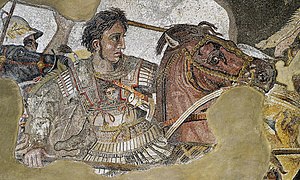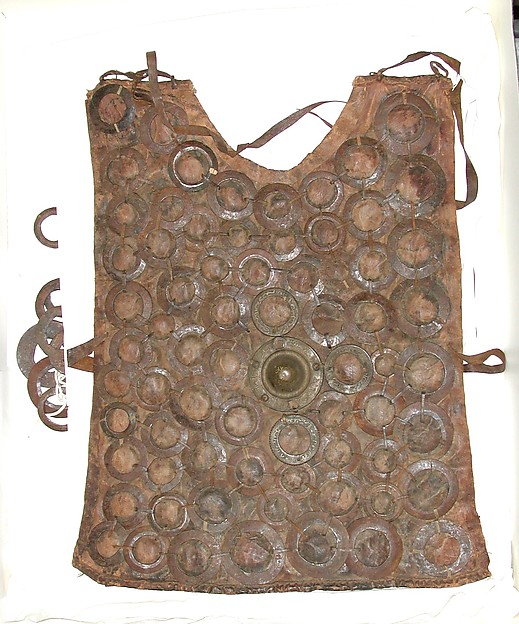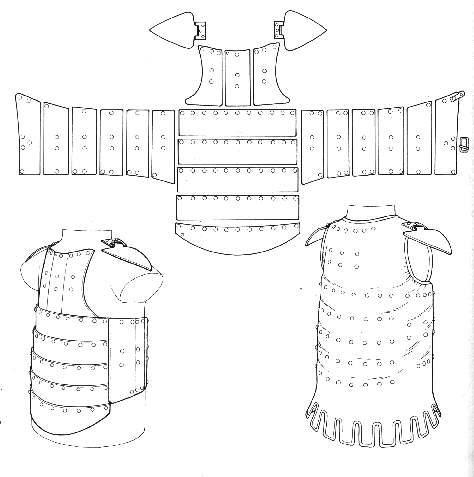I am pretty sure the special children at Wizards of the Coast have never actually looked at or worn medieval armor. But never fear, purist! For my small voice shall be like unto a single candle in the darkness.
I'm going to restrict this post to pre-modern armors. That is a broad enough subject without considering modern materials or threats. I can see the topic extending to several posts without even stretching.
Original D&D and B/X had three armors: leather chain and plate. This is great if you are trying to keep it simple. Advanced D&D added many more options Here is a list organized by AC adjustment, not including helmets or shields.
Sweet Jesus. What a muddle! Gary tried, didn't he? Gary's main source was books like Charles Ashdown's histories of arms and armor; essentially a bunch of Victorian guesswork. That is why everything is called "Mail." Back in the day, the only thing called "mail" was chain mail. That was what the word meant. Note the inclusion of "Banded Mail." Even though Gary himself admitted that no-one knew what Banded Mail was, he still managed to assign an armor value to it. Banded Mail was just a term used to describe what was probably an artistic representation of chain.
Here's the armor listing from 3rd:
If weapons are difficult to type up for a rule set, Armor is utterly boggling. Books tend to make an attempt to describe the material or construction of armor, but they generally don't describe the amount of coverage. Are we talking just the torso? head to toe coverage? Is the necessary padding and under-layers included? Are bracers and greaves included? 3rd edition rules make a fair attempt at this, which is necessary since many of the armors listed are different styles of similar materials.
More often than not, Warriors would mix and match the material of their equipage, or dress in layers. Very few rulesets allow for wearing multiple layers of armor. (Anima does. But who has even heard of Anima?)
These are important questions. But before we can consider them we should probably just review the armors by their basic types.
Padded Armor
Meant to refer to quilted or textile armors. You will get farther with reenatctors and historians if you refer to them as gambeson. These don't get a lot of cred in most rulesets. 4th edition takes a page from World of Warcaft and defines armor types by material rather than style. There is some good sense to this because not all "padded" armors are created equal.
Some gambesons are rather thin and intended to do little more than protect the wearer from his own armor and prevent it from "biting."
Others provide a serious level of protection, especially from concussive blows, and are thick enough to absorb the bite of a slashing edge. At this level, they can be rather bulky, and while not "heavy," they are not the sort of thing for your acrobatic thief would wear.
Textile armors offer many advantages which would appeal to an adventurer: They offer warmth and are easier to store and transport than rigid plate-armors. They are also less prone to rust, and lower-maintenance. They can be humble in appearance, or richly embellished.
Textile armors are also less conductive of energy, which would make them superior for resisting magical attacks.
The Linothorax
Literally a "linen cuirass," this was an antique example of textile armor. There are no surviving examples of this armor type, but it is referenced in literature and depicted in art. The linothorax was made of many layers of linen. Nerds debate as to whether these layers were laminated together with a sort of glue (which would make a material similar to fiber-glass) or if they were merely quilted. Either way, the multiple layers of linen provide excellent protection, even from arrows and piercing attacks, in a manner similar to a modern kevlar vest.

Alexander the Great depicted wearing a Linothorax.
Cloth Armor: Not just for Plebs and Magic-users any more.
Leather Armor
As obvious as it seems to make armor out of leather, there is not a lot of historical record of it. It also doesn't help that cured animal skin does not stand the test of time well.
Leather was used in armor, but mostly as a connective material or a foundation for the main defensive element. When it was used as the main defensive element, it was never plain leather, but either rawhide or treated with lacquer or wax or cuir-boullied.
Cuir Boulli means "boiled leather." It refers to the range of techniques for hardening leather by "tempering" it in near-boiling water or impregnating it with wax or both.
While it is easy enough to form leather into large, rigid sheets and use it to imitate the style of plate armor, it seems like this is not how leather was usually applied. It was more typically configured into scales or lamellar. The reason for this is probably that the leather pieces overlap in a scale or lamellar configuration, making it much more effective at stopping piercing attacks or ablating concussive force. Leather in a "plate" configuration would not be as effective.
Reproduction of Egyptian leather scale. Rawhide-on linen backing. Made for a Nova special. It looks chintzy, but it has amazing protective power.
Muscle Cuirasses were real, but were largely decorative or meant for ostentation. Leather-plate cuirasses like this may have existed, but were almost certainly decorative.
More supple leather can also be uses as a padding-layer for heavier armor. a fair example of this would be the buff coat- which is basically a frock coat made of leather.
But since this is the realm of D&D and Hide Armor is a thing, we can guess that armor made of alligator or rhino hide would be very protective. But considering the sheer bulk of the material, metal armor would be much sleeker and less bulky. You can make articulated gauntlets from steel, but not from half-inch thick hide.
Studded Leather is another bizarre Gygaxian Anachronism. It's wasn't a real thing. Medieval men at arms didn't say to themselves "Hmm. Methinks I shall dispense with a few extra groats and purchase the studded cuir-boulli. It doth protect more verily by five per-centum!" Sure, you could stick a few decorative rivets on leather armor. But why would you distinguish it from other leather armors in your ruleset?
Studded leather is however useful if you are making a movie and you want to portray brigandine or a coat-of-plates on a budget.
Ring-Mail was a real thing though.
Defined as metal rings stitched onto a cloth or leather backing. It might not be your first choice of armors. But it has a sort of improvised, road-warrior sort of appeal.
Sudanese chest piece. dated to 1744, Metropolitan Museum of Art.


German, dated 1376. from effigiesandbrasses.com. This fellow's bracers and greaves are splint-armor. Sometimes the splints were on the inside of the leather foundation. When the splints are on the inside, they are indicated the rows of rivets. Note that this fellow's knee and elbow copps are made of plate in conjunction with the splint. He is depicted standing upon a dragon to indicate his personal, spiritual triumph over evil and the devil.
Here is some more primitive-styled splint armor by getdressedforbattle.com. It is supposedly a "Viking" style but it looks more road-warrior to me.
Scale Armor
Scale armor was popular from ancient times, through the Roman period, into the Migrational period (aka the Dark Ages.) But by the Middle-Ages, it had lost currency and was almost entirely replaced by chain. It is easy to guess why scale armor had its day though. Scale is simple to produce and to repair. It can be made from a variety or materials; leather or bronze or steel. It does not require a high level of metallurgy to produce plates of sufficient size. The mere concept is naturally inspired and aesthetically pleasing.
A Pangolin: One of the world's most hunted animals. Its keratinous scales protect these endangered animals from most predators, but not so much from South-East Asians who will try to eat or make folk-medicine out of anything.
Scale would be almost completely replaced by chain for reasons I would have to guess at, except for sparse use in transitional armor rigs where it was used to cover areas like the hips or shoulders:
German, 1421.From effigiesandbrasses.com
Chain MailInvented around perhaps 400 or 500 BCE, Maille has been one of the most common and recognizable armor types for over two millennia, and still sees practical use to this day. The basic technology required to create maille is the capacity to draw large amounts of wire. Not all Maille is created equal The strength of the mail depends on the gauge of the wire used, the diameter of the individual links, the style of weave (European 4-in-1 is the most common,) and the method by which the links are close. They may be welded, riveted (very tiny rivets), butted together (the weakest) or perhaps a solid ring (but the solid rings still need to be connected to each other by some other method). Weaving chain by hand is a time-consuming process and is a huge factor of the cost of the armor. The "augmented" and "double" maille refer to alternate styles, heavier or more protective than standard chain.
European 4-in-1 pattern
drawn by M.C. Escher, apparently. Thanks for this, WotC
The 3E rules distinguish between a chain shirt and chain mail. A Chain Shirt might refer to a t-shirt or "hauberk" which covers the upper arms and the tops of the thighs. The more protective "chain mail" probably signifies a full-body suit such as those worn by these crestfallen warriors:
Maille is often depicted as very form-fitting. Maille is very easy to tailor to the wearer; a baggy suit would only weigh extra! Maille also tends to weigh on itself and hug its wearer. This low profile makes it good for wearing hidden.
Maille is extremely flexible, making it good for armoring areas like the throat, groin or armpit. For this reason, it is often worn under more rigid armors or stitched directly onto a gambeson.
Maille effectively defeats edged weapons. But it is not exactly proof against strong or acute piercing attacks, and it does little to soak or spread concussive force. For this reason, Maille was often worn over a gambeson to offer a degree of padding. Or perhaps because Maille is a heat-sink and a gambeson keeps you warm.
Lamellar
Refers to styles of armor comprised of small, overlapping plates which are laced together in a repeating pattern. As with scale armor, the overlapping plates distribute the energy of a blow very effectively. But unlike scale, lamellar plates are not pinioned to a backing, but laced through eachother; top, bottom and side to side. This renders it less flexible, but effectively more protective.
Lamellar is relatively easy to produce from a variety of materials: from leather and bone to metals and modern materials. The lacing of lamellar is exposed though, and I expect it would require regular maintenance and repair when subjected to the rigours or combat with live weapons.
uh. um. What was I talking about?
Plate Mail
Is another one of those Victorian neologisms which was used to refer to the plate armor of the late Medieval and Renaissance period. In AD&D however, Gygax describes it as chain-mail armor with steel plates woven onto the links. This is actually a real thing. After all, if your chain is form-fitting, why not point plate-armor onto it?
plates of horn -Philippine origin. 1800s. I'd wear that.


Diagram showing small, overlapping plates. Because of this, I would class plate-mail as lamellar for rules purposes. Or else as splint-armor layered on chain.
Coat of Plates & Brigandine
It became apparent that against medieval weaponry, larger, wider plates provided greater protection than scales, lames or chain. A wider plate ablates the force of a blow over a wider area, and is lighter by virtue of not overlapping with other plates. As smithing techniques improved, it became possible to form larger sections of armor. Armor which covered the same area required fewer pieces, but more complex ones. This began what is called the "transitional" period in European armoring. It can be roughly placed over the 14th century. And as the name implies, this was the period in which fighting men transitioned from chain to plate armors. The distinctive armors of the transistiona period are Brigandine, and Coat-of-Plates. Gygax accurately describes brigandine as steel plates riveted on the inside of a cloth or leather front.
From the outside; looks like leather with studs. On the inside: the main defensive element is steel plates. This on the right is a rather busy example. The numerous rivets and the overlapping would make it heavier, but also more flexible than a simpler layout.
Here is a simpler layout: essentially splint armor for the torso called the Wisby CoP.

Plate
Perhaps the most exotic and misunderstood form of body armor. in game terms, plate armor is generally considered to be heavy and bulky. It had potential to be so, but not necessarily. Like many other forms of armor, not all plate was created equal.
Indeed, some plate is intended to lock you onto the top of a charging horse, transforming you into something more like a tank than a man-to-man combatant. If you were to dismount and attempt to fight normally, it would be indubitably restrictive:

For the most part however, plate armor at its apex was fitted specifically to the wearer. It was thoroughly articulated and allowed for a great degree of flexibility and agility. If you cannot move, you cannot fight, and people are not in the habit of making armor that doesn't work. It may not have been the sort of thing you would want to spend all day in (which might be necessary in warfare,) but you would likely have preferred to fight with it than without.
 So called "half-plate." Example shown here was used by Swiss mercenaries. So called "munitions" grade armor, without having to include arms or legs, half plate did not require such extensive personal tailoring and was easier to produce in quantity. Plate armor; not just for super-rich nobles anymore.
So called "half-plate." Example shown here was used by Swiss mercenaries. So called "munitions" grade armor, without having to include arms or legs, half plate did not require such extensive personal tailoring and was easier to produce in quantity. Plate armor; not just for super-rich nobles anymore.The development and proliferation of hand-held gunnery turned conventional armors into a liability. Distance, cover and concealment became the new best defenses.
For a while, late-period armors and firearms used in concert were an over-whelming force, and established a firm foothold for colonial and imperial interests, particularly in the Americas.
But where two modern armies met, armor proved ineffective. It was possible to make plating which was proof to bullets, but they were of such weight that it was impractical to wear more than a cuirass of the stuff. Even modern ballistic armors are rarely designed to cover more than the vital organs.
In the figurative arms race between defense and offense, gunpowder weapons gave offense such a lead that it seems the rest of the world is still caching up.
I hope you enjoyed this survey of armors. It is hardly exhaustive, but these arms and armor surveys are exhausting to put together.
And that's not even touching the rules yet.













.jpg)

No comments:
Post a Comment